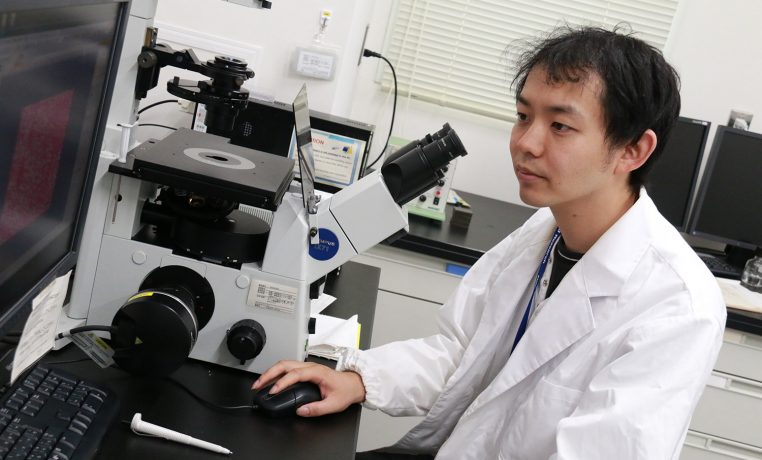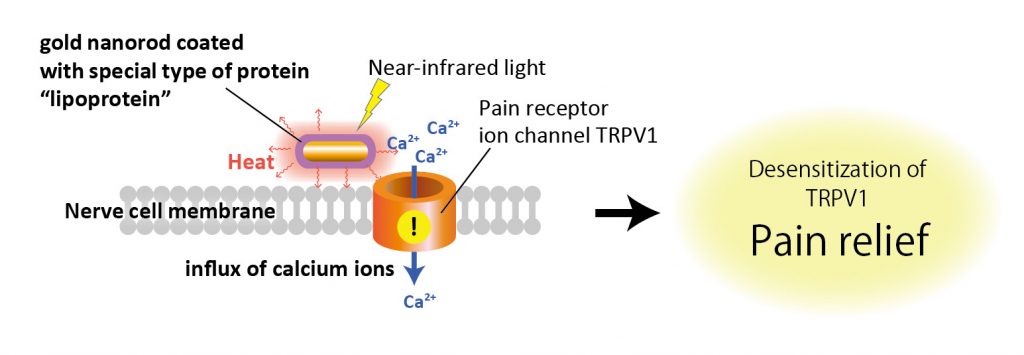(iCeMS Imahori Lab*)
* iCeMS Murakami Lab when paper released
Hirotaka Nakatsuji
Hirotaka Nakatsuji
The doctoral student Hirotaka Nakatsuji is focusing on biological applications of light-responsive nanomaterials, like the materials used for solar cells. In this research, he attempted to control the pain receptors in our neurons with light.

Please share with us the significance of your manuscript in terms of its research achievements, impact, or uniqueness.
In this paper, I report the “photocontrolling of thermosensitive ion channels”. In our group, photoresponsive materials from organic solar cells are a major field of study. I explored possibility of interesting biomedical application using these photoresponsive materials.
In this study, we focused on TRPV1 channel, which is a nociceptor in sensory neurons. TRPV1 is a nonselective cation channel that is activated by temperature (>43 ℃), physical and chemical stimuli. Thus, TRPV1 provide sensation of heat and pain. We came up with the idea photocontrol of TRPV1 might become possible with plasma membrane-targeted photothermal nanomaterials. Such technologies could further lead to the on-demand manipulation of neuronal cell functions and the development of phototherapies against pain.
Gold nanorods (AuNRs) are rod-shaped gold nanoparticles that have high photothermal effect under illumination of near-infrared light, which is minimally invasive to our body. By utilizing our findings on drug delivery system (DDS) research conducted so far, we succeeded in the efficient and safe delivery of AuNRs to the plasma membrane expressing TRPV1 via controlling the surface chemistry of AuNRs. We found that upon near-infrared illumination TRPV1 in the AuNR-treated cells was activated without membrane disruption. This method provides an optogenetic platform without prior genetic engineering, which may be useful for phototherapeutic approaches.
What would you say is the most exciting or “I made it!” moment during this research project?
Of course, it was the moment that TRPV1 was activated. In this study, we used a fluorescent Ca2+ indicator to evaluate activation of TRPV1. At the moment cells became fluorescent by the laser irradiation, I instinctively raised fist. However, the experiments have a low success rate at first. So then, every two minutes I swung from joy to sorrow and back again by the experimental results and became mentally exhausted.
Please tell us about the biggest challenge or problem you experienced while conducting your research. How did you overcome it?

I had a lot of trouble to control photothermal heating of cells for safe TRPV1 activation. If temperature rises too high, cells would be damaged via membrane disruption. So then, these experiments demanded precise temperature control. We tried adjusting various experimental conditions, including size, dispersants, concentration of AuNR, laser power and type of laser. After some time, our intense efforts led to success.
Would you consider this work to be a turning point in your overall research direction? If so, how has your research direction changed as a result of this work?
Hmm, it is too early to consider this work as a turning point. Instead I think this is a starting point for me. I learned the difficulties of building up multidisciplinary research from scratch, organizing it and writing a paper with scientists from different research fields. I realized that I still have a lot of things to learn.
Please describe the current situation of your career. What is your current position? How has the knowledge and experience gained at iCeMS influencing your career?
I am still working in iCeMS as a doctoral student. I am working hard to write my doctoral dissertation within this year. In iCeMS, I have many opportunities to communicate with senior researchers that belong to other groups. That has given me the chance to gain knowledge and concepts from other fields.
*All the information on this page, including the researcher’s affiliation, is current at the time of the interview.
Paper information
Thermosensitive Ion Channel Activation in Single Neuronal Cells by Using Surface-Engineered Plasmonic Nanoparticles
Nakatsuji Hirotaka, Numata Tomohiro, Morone Nobuhiro, Kaneko Syuji, Mori Yasuo, Imahori Hiroshi, Murakami Tatsuya.
Angewandte Chemie International Edition
Published: August 2015
DOI: 10.1002/anie.201505534.